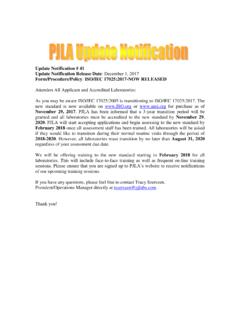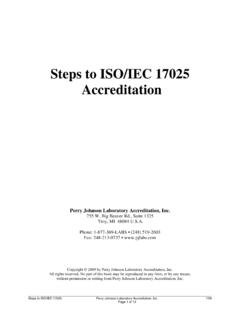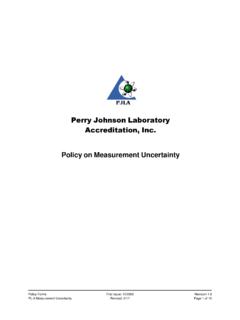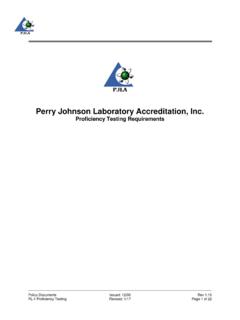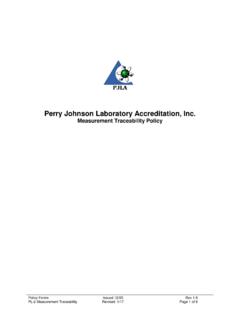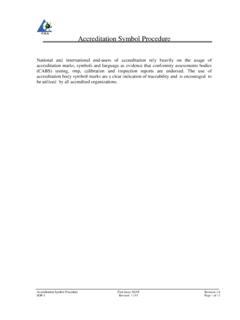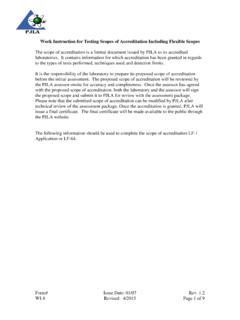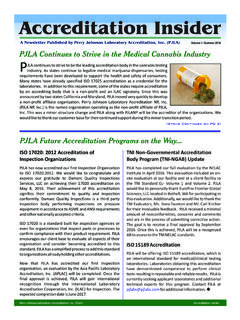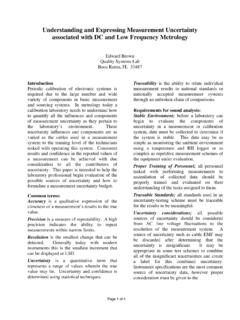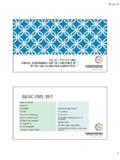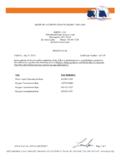Transcription of ISO/IEC 17025:2017 Working Document Instruction …
1 ISO/IEC 17025:2017 Working Document Instruction Page NOTES: 1. This Working Document is intended as a checklist for the assessor when conducting Testing and Calibration Laboratory and Sampling Organization Assessments according to ISO/IEC . 17025:2017 . This standard incorporates all elements of ISO 9001:2015 relevant to testing and calibration laboratories and Sampling Organizations. Organizations that already have ISO. 9001:2015 for their scope of service similar to their accreditation scope will be held to the requirements as referenced in Clause 8, Option B which eliminates a full assessment to clauses However, assessors should ensure that the laboratory has incorporated this standard in their quality system regardless of their ISO 9001:2015 certification.
2 Clauses highlighted in blue are new changes/addtions not in previous versions of ISO/IEC . 17025 and can be used for transition assessments. 2. Please make notes in the Comments column any deficiencies in the laboratory's management system identified during the assessment (see item #3). These observations may be useful when preparing the assessment report and indicate to the reviewer that a thorough assessment was conducted. It is also imperative to note evidence of compliance, making reference to procedures/work instructions , dates, and other specific observations. At a minimum should be 1 comment per major element of the checklist.
3 3. Do not recommend specific solutions to deficiencies, as this would constitute a conflict of interest. 4. Assess the system only to the relevant standard and to the requested scope of accreditation. Do not be concerned with system requirements stemming from: Company- or facility-imposed policies, Regulatory bodies, Subcontractors,Other sources 5. If additional questions arise during the assessment, indicate them (and the appropriate responses) either in the blank Working Document pages at the end of this Document or in the empty rows included in some of the sections. 6. Please read the questions carefully, as the preferred answer in some cases may be no or not applicable.
4 7. If, at any time, the assessment team requires assistance in the interpretation of the requirements of ISO/IEC 17025 : 2017 , contact the PJLA office immediately. Form # Issued: 2/17 Rev. LF-56- 17025 - 2017 Working Document New 1 of 32. ISO/IEC 17025:2017 Working Document Section Assessment Yes No Comments/Policy/Procedure/Record 4 General Requirements Impartiality Has the laboratory undertaken impartially and structured and managed activities so as to safeguard impartiality? Is the laboratory management committed to impartiality? Is the laboratory responsible for the impartiality of it's laboratory activities and do not allow commercial, financial or other pressures to compromise impartiality?
5 Does the laboratory identify risks to it's impartiality on an on- going basis? Including those risks that arise from its activities, or from its relationships, or from the relationships of it's personnel? However, such relationships do not necessarily present a laboratory with a risk to impartiality. A relationship that threatens the impartiality of the laboratory can be based on ownership, governance, management, personnel, shared resources, finances, contracts, marketing (including Note branding), and payment of a sales commission or other inducement for the referral of new customers, etc. If a risk to impartiality is identified, is the laboratory able to demonstrate how it eliminates or minimizes such risk?
6 Confidentiality Is the laboratory responsible, through legally enforceable commitments, for the management of all information obtained or created during the performance of laboratory activities? Does the laboratory inform the customer in advance, of the information it intends to place in the public domain? Except for information that the customer makes publicly available, or when agreed between the laboratory and the customer ( for the purpose of responding to complaints), all other information is considered proprietary information and shall be regarded as confidential. When the laboratory is required by law or authorized by contractual arrangements to release confidential information, is the customer or individual concerned, unless prohibited by law, be notified of the information provided?
7 Does the laboratory ensure that Information about the customer obtained from sources other than the customer ( complainant, regulators) is confidential between the customer and the laboratory? Is the provider (source) of this information confidential to the laboratory and not be shared with the customer, unless agreed by the source? Form # Issued: 2/17 Rev. LF-56- 17025 - 2017 Working Document New 2 of 32. ISO/IEC 17025:2017 Working Document Does personnel, including any committee members, contractors, personnel of external bodies, or individuals acting on the laboratory's behalf, keep confidential all information obtained or created during the performance of laboratory activities?
8 5 Structural Requirements Is the laboratory a legal entity, or a defined part of a legal entity, that is legally responsible for its laboratory activities? For the purposes of this Document , a governmental laboratory is Note deemed to be a legal entity on the basis of its governmental status. Does the laboratory identify management that has overall responsibility for the laboratory? Does the laboratory define and Document the range of laboratory activities for which it conforms with this Document ? Does the laboratory only claim conformity with this Document for this range of laboratory activities, which excludes externally provided laboratory activities on an ongoing basis?
9 Laboratory activities shall be carried out in such a way as to meet the requirements of this Document , the laboratory's customers, regulatory authorities and organizations providing recognition. This shall include laboratory activities performed in all its permanent facilities, at sites away from its permanent facilities, in associated temporary or mobile facilities or at a customer's facility. The laboratory shall: a) define the organization and management structure of the laboratory, its place in any parent organization, and the relationships between management, technical operations and support services;. b) specify the responsibility, authority and interrelationship of all personnel who manage, perform or verify work affecting the results of laboratory activities.
10 C) Document its procedures to the extent necessary to ensure the consistent application of its laboratory activities and the validity of the results. The laboratory shall have personnel who, irrespective of other responsibilities, have the authority and resources needed to carry out their duties, including: a) implementation, maintenance and improvement of the management system;. b) identification of deviations from the management system or from the procedures for performing laboratory activities;. Form # Issued: 2/17 Rev. LF-56- 17025 - 2017 Working Document New 3 of 32. ISO/IEC 17025:2017 Working Document c) initiation of actions to prevent or minimize such deviations.
